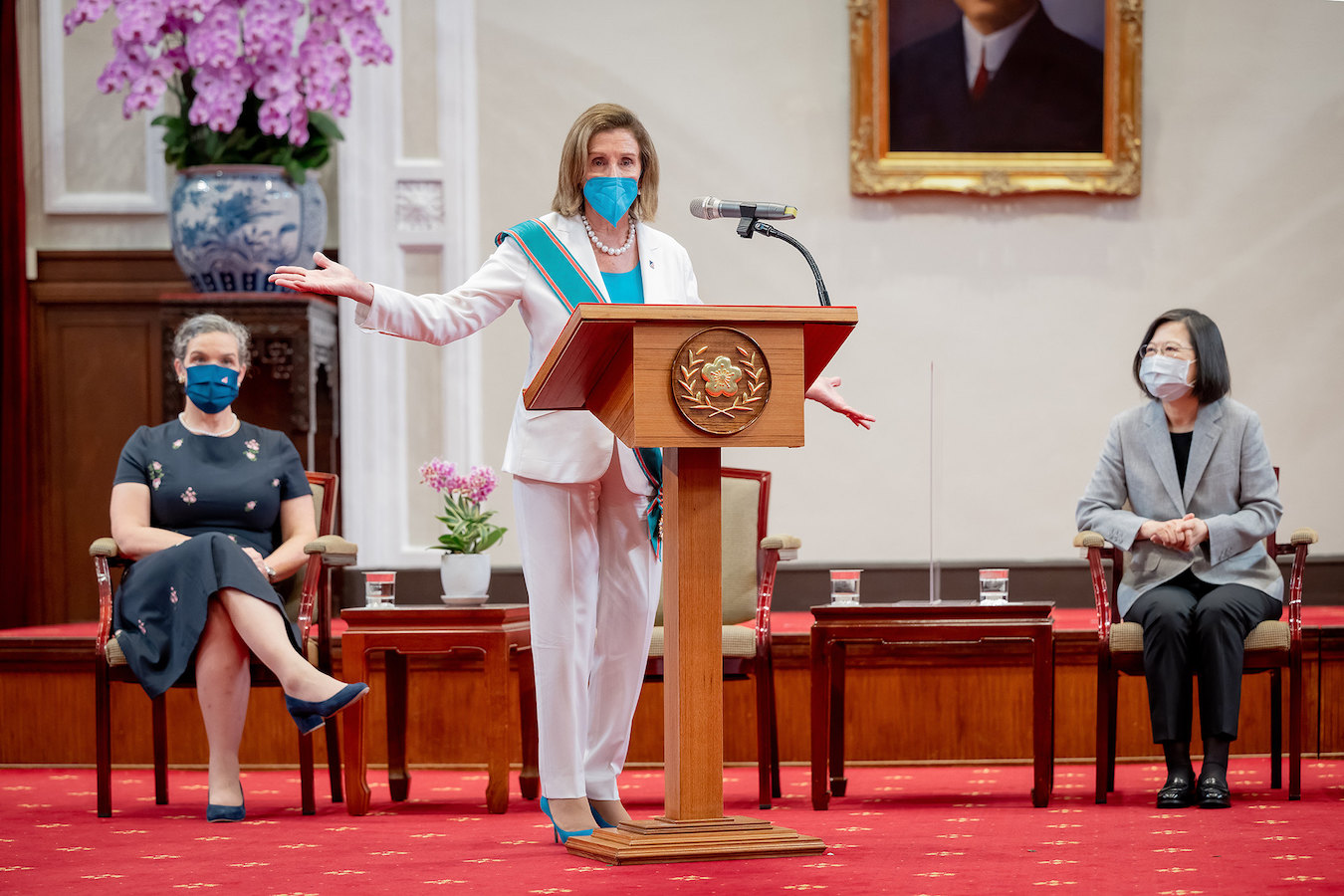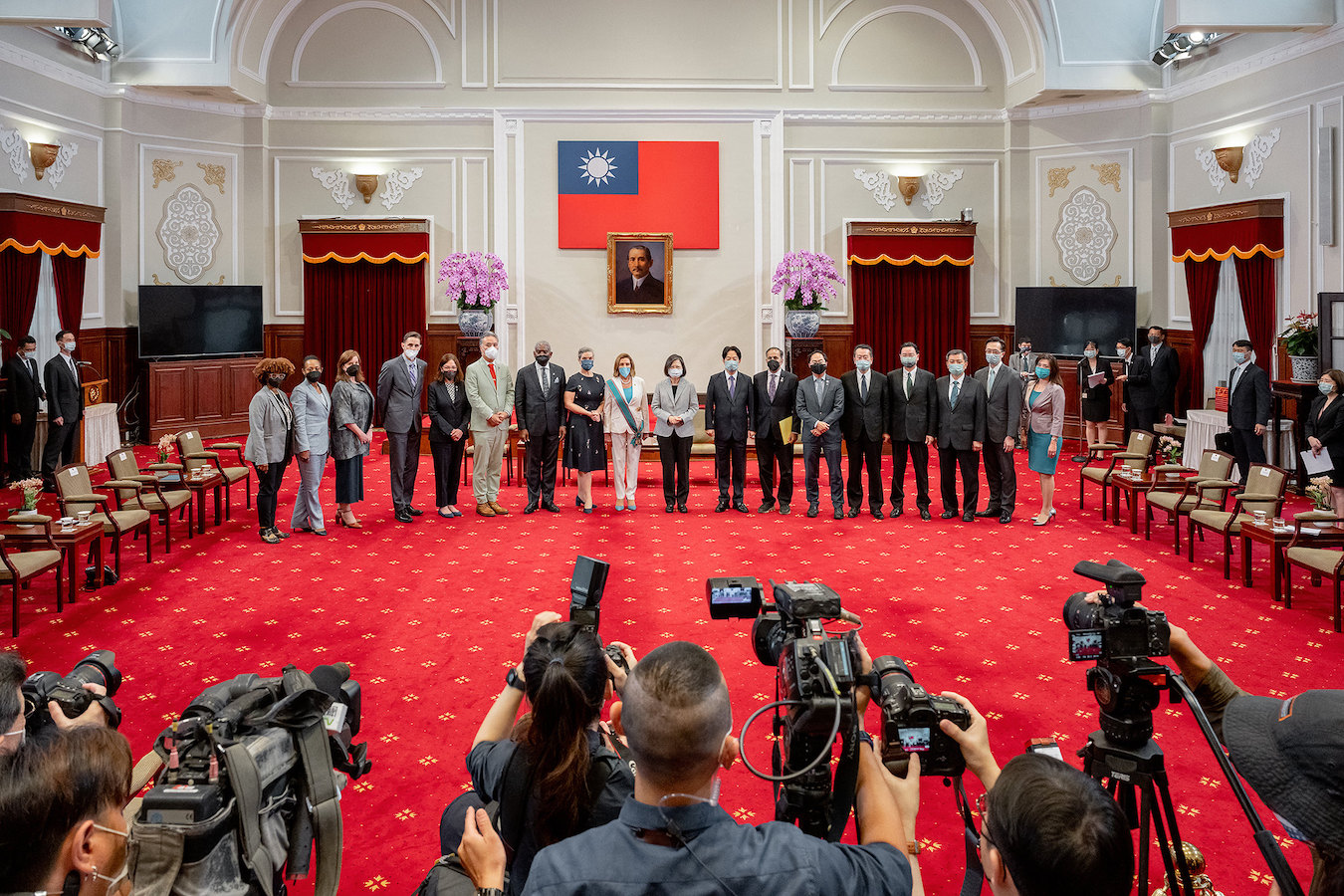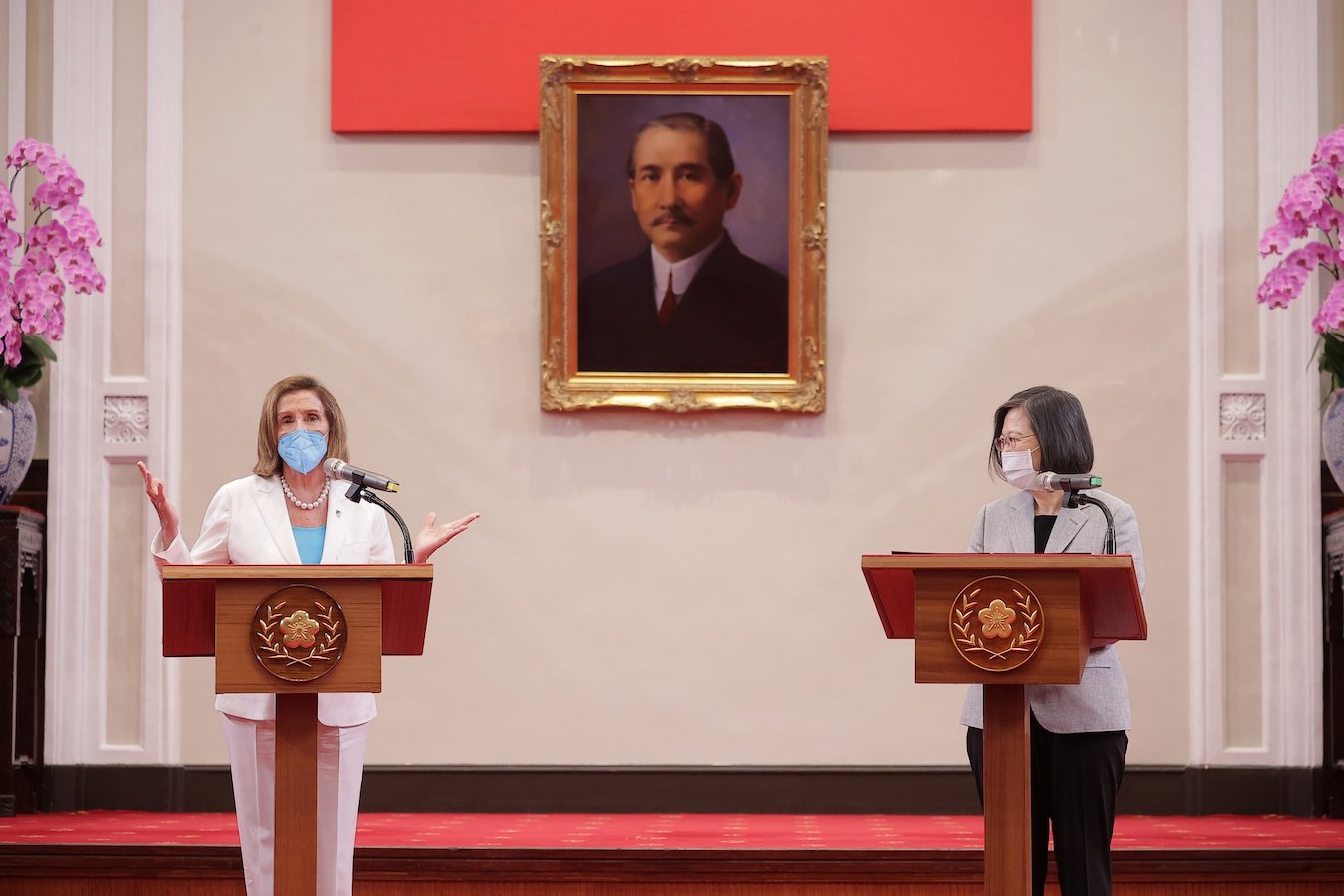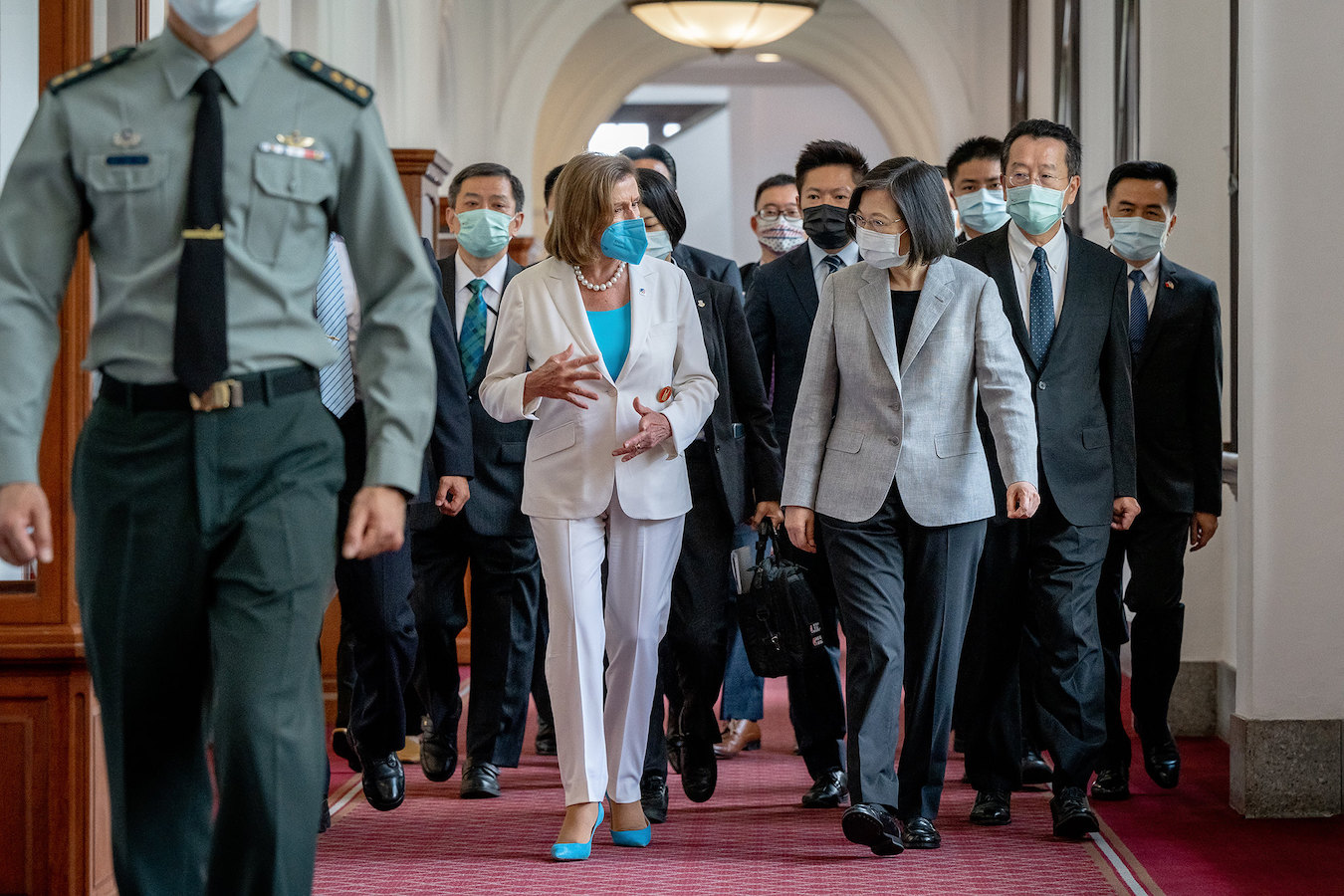by Brian Hioe
語言:
English
Photo Credit: Simon Liu/Office of the President/Flickr/CC BY 2.0
US HOUSE SPEAKER Nancy Pelosi’s visit to Taiwan, which began yesterday after she arrived at Songshan Airport at 10:43 PM and ended today around 4:45 PM, has been eventful . Pelosi is the highest-ranking US elected official to visit Taiwan in a quarter of a century, the last such visit having been Newt Gingrich’s visit in 1997. Pelosi’s visit was significantly more high-profile than Gingrich’s visit, which involved a larger delegation but was only for three hours. Unlike Gingrich, Pelosi stayed overnight and met with not only the Taiwanese president but spoke with the legislature.
Pelosi was originally scheduled to visit Taiwan in April, as a move to reassure after Russia’s invasion of Ukraine. However, the visit did not take place because Pelosi caught COVID.
The timing for the more recent visit, then, was very different. For one, news of the visit prematurely broke after a scoop from the Financial Times. This led to much discussion of the possible consequences of the visit, with some even arguing that the visit could lead to a Fourth Taiwan Straits Crisis.
 American Institute in Taiwan director Sandra Oudkirk (left), US House Speaker Nancy Pelosi (center), and Taiwanese president Tsai Ing-wen (right). Photo credit: Makoto Lin/Office of the President/Flickr/CC BY 2.0
American Institute in Taiwan director Sandra Oudkirk (left), US House Speaker Nancy Pelosi (center), and Taiwanese president Tsai Ing-wen (right). Photo credit: Makoto Lin/Office of the President/Flickr/CC BY 2.0
The visit became further complicated when US president Joe Biden stated in public comments that he viewed the visit as inadvisable, citing the US military. Pelosi downplayed such comments, stating that Biden may have feared her plane being shot down because news broke ahead of time about the visit.
It is not surprising that Biden made such comments in light of the fact that he was to speak with Chinese president Xi Jinping in late July. Nevertheless, some speculated that Biden made these comments in order to distance himself from Pelosi for his talks, while others took the view that this represents lack of coordination between the legislative and executive branches of the government. Subsequently, the Biden administration stated that it could not prevent Pelosi from going to Taiwan if she intended to. There likely would not have been as strong a reaction in international discourse if the visit only became known after Pelosi arrived in Taiwan. This is what has usually taken place with visits to Taiwan by US government officials under the Biden administration, as to be contrasted with the preceding Trump administration.
Pelosi spoke at the Taiwanese legislature and met with President Tsai Ing-wen this morning. Pelosi’s comments generally framed Taiwan and the US as having common cause for cooperation regarding economic ties, mutual security interests, and “shared values of self-governance and self-determination” as the basis for abiding friendship between the US and Taiwan.
Pelosi did not bring up the One China Policy during her comments, even as the Biden administration has otherwise emphasized that its policy on Taiwan has not changed regarding the visit. This may have been deliberate given that Biden, who is known for frequent gaffes on China and other issues, has often made comments seemingly expressing commitment to defend Taiwan before this was walked back by the State Department–leading to debates as to whether this pattern is deliberate or not. Pelosi may have sought to frame this pattern of supportive statements for Taiwan quickly being walked back as, in fact, deliberate in some way, if it is not only Biden who does this.
 Photo credit: Makoto Lin/Office of the President/Flickr/CC BY 2.0
Photo credit: Makoto Lin/Office of the President/Flickr/CC BY 2.0
To this extent, Pelosi pointed to the importance of the CHIPS Act for strengthening US-Taiwan cooperation. Ironically, the CHIPS Act is aimed at strengthening US self-sufficiency regarding semiconductors which it is currently reliant on Taiwan from, so it is to be questioned whether Pelosi is framing a measure intended to make the US less reliant on Taiwan as one that would in fact benefit Taiwan. According to DPP majority speaker Ker Chien-ming, Pelosi spoke with him and TSMC chair Mark Liu about semiconductors this morning.
Otherwise, Pelosi stressed the bipartisan nature of the visit. When speaking with Tsai, Pelosi emphasized the history of bipartisan criticism of China, such as regarding the Tiananmen Square Massacre. Indeed, in the afternoon, as what is expected to be one of Pelosi’s final events during her stay in Taiwan, Pelosi met with former Tiananmen Square student leader Wuerkaixi, who lives in Taiwan, formerly kidnapped Causeway Bay bookseller Lam Wing-kee, who lives in Taiwan after fleeing his native Hong Kong, and Lee Ming-che, the Taiwanese human rights NGO worker who was arrested by the Chinese government for five years on charges of seeking to subvert the state.
After much discussion in international discourse playing up the consequences of the visit, it was unlikely that China would not feel obligated to respond to the Pelosi visit with some strong show of force–otherwise, this might be perceived as making China look weak. This is one way in which international discourse does, in fact, have a concrete impact on geopolitical circumstances.
Pelosi’s motives for the visit are, on the whole, somewhat opaque. Some interpret Pelosi as hoping for a political move to cement her legacy as a liberal critic of China. Otherwise, Pelosi’s actions may be aimed at pressuring Biden regarding Taiwan. Or Pelosi may have hoped to depict the Democrats as strong on China through supportive moves of Taiwan, seeking to answer to an increasingly vocal demographic in the US opposed to China that has thrown its weight behind the Republicans.
The Pelosi visit can be situated in the framework of the debate between strategic ambiguity and strategic clarity in policy circles, in that a visit by such a high-ranking US government official to Taiwan will be perceived as pushing the US closer to strategic clarity–meaning commitment to defend Taiwan rather than ambiguity on the subject. But, as with how some have warned that strategic ambiguity could lead to greater Chinese aggression against Taiwan, some take the view that Taiwan would have gained little from the visit, and that the gesture would only be symbolic.
A report in the China Times before the visit cited a leak, claiming that the Tsai administration had attempted to disinvite Pelosi but that Pelosi had pressed ahead with the visit anyway. The China Times has been reported on by the Financial Times and Apple Daily as accepting funding and say in its editorial direction from the Chinese government and it is owned by the Want Want Group, whose owner Tsai Eng-meng has made no secret of that his interest in acquiring media companies is to advance pro-China views. Either way, regardless of the veracity of the report, even if the visit may have put Taiwan in the crosshairs of potential reprisal from China, Taiwan would have little capacity to say no to Pelosi.
Shortly before the visit, China announced an import ban on one hundred Taiwanese food products. Chinese naval vessels were also sighted off of Orchid Island.
Not long after Pelosi touched down, China announced that it would be conducting live-fire exercises around Taiwan from August 4th to August 7th. Though this is after Pelosi is scheduled to leave Taiwan, concerns have been raised regarding the fact that the exercises take place within some of Taiwan’s sovereign territorial waters. The exercises will take place closer to Taiwan than during the Third Taiwan Straits Crisis. Air incursions that touched upon the median line of the Taiwan Straits also took place during the visit by 21 Chinese aircraft.
 Photo credit: Chien Chih-Hung/Office of the President/Flickr/CC
Photo credit: Chien Chih-Hung/Office of the President/Flickr/CC
Pelosi’s plane took seven hours to reach Taiwan from Malaysia, seeing as it avoided the South China Seas. Some Taiwanese media reports suggested that US aircraft activity in the region yesterday was because of air incursions near airspace that Pelosi’s plane was scheduled to pass through.
Ahead of the visit, the ROC military announced that it would increase military readiness and hold military exercises next week, though it was not on war footing. US naval vessels were also deployed to the region ahead of the visit and eight F-15s were moved by the US to Okinawa.
The Maritime and Port Bureau has announced areas for fishing vessels to avoid during the live-fire drilling by China, with fishing vessels to make their locations known, and notify authorities if they encounter Chinese vessels. It is not impossible that China steps up grey zone tactics in the future, taking advantage of the desire of the Taiwanese government to avoid conflict. Some ports will be unable to operate due to the drills, which may provide political momentum to push Taiwan toward future measures aimed at preventing a Chinese blockade.
And even then, it is not impossible that one sees a pattern of tit-for-tat escalation between the US, Taiwan, and China in the coming days that could significantly increase the odds for conflict. This is particularly dangerous in light of the fact that Chinese nationalists are among those unhappy with what they see as insufficient action to prevent the Pelosi visit and the CCP leadership may feel that it needs to answer to this demographic.
Taiwan’s highly sensationalist media, which often reports on unverified information as fact and frequently mines social media for information, could be a contributing factor to escalation if it serves as a vector for propagating misinformation and disinformation. Taipei’s Taoyuan International and Songshan Airports have emphasized that flight cancellations today have nothing to do with Chinese drills.
Either way, with China announcing new economic actions, such as bans of citrus fruit imports from Taiwan to China and natural sand exports to Taiwan from China, one expects continued attempts to economically pressure Taiwan. China may have a list of trade measures directed toward Taiwan that it will gradually announce in the coming days.
Most political parties in Taiwan with electoral representation publicly supported the visit, with DPP politicians denying claims that the Tsai administration did not welcome Pelosi, and even the pro-unification KMT welcoming Pelosi, seeing as current chair Eric Chu is attempting to change the party’s pro-China image and depict it as US-friendly. Hundreds gathered at Songshan Airport to watch Pelosi’s plane arrive, as well as outside the Grand Hyatt Hotel where Pelosi stayed. More than 700,000 watched the flight on FlightTracker24, an aviation tracking website.
Deep blue parties such as the New Party and Chinese Unification Promotion Party (CUPP), the latter of which has organized crime ties, demonstrated against the visit with the claim that Pelosi and the US were dragging Taiwan into conflict. Given the CUPP’s gangster ties and because of threats to bomb Taoyuan International Airport with the apparent mistaken belief that Pelosi would arrive there rather than the Songshan Airport, hundreds of police were deployed as security for Pelosi at the hotel and at Songshan Airport.
 Photo credit: Makoto Lin/Office of the President/Flickr/CC BY 2.0
Photo credit: Makoto Lin/Office of the President/Flickr/CC BY 2.0
7/11s across Taiwan and some Taiwan railway stations displayed electronic signs protesting the Pelosi visit after a hack today. The hack may not originate necessarily from anything as complex as a state actor, however, as poor digital security in Taiwanese companies may contribute to monitor displays easily being hacked.
Pelosi left Taiwan on a plane that departed at 4:45 PM. Pelosi will next resume her Asia tour. Nevertheless, the coming days will continue to be tense in terms of regional security. That being said, the mood in Taiwan remains calm. The Pelosi visit only gained significant attention in Taiwan shortly before it took place despite weeks of heated discussion in international discourse and the general public was not very reactive to Chinese threats ahead of the visit.
Chinese threats, after all, have taken place for decades and occur with such frequency that they often don’t faze the public, especially given that they usually take place at a distance from Taiwan. This was the case with the Pelosi visit, too. It is to be seen if the situation changes, particularly as images of Chinese drills start to circulate through social media in the coming days, or if the drills lead to some precipitating incident.

